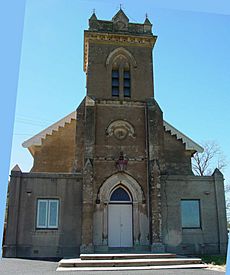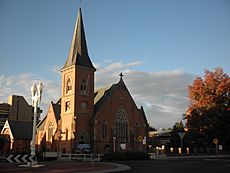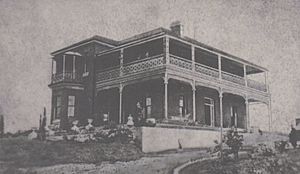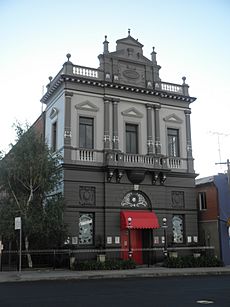Architecture of Bathurst, New South Wales facts for kids
Architecture in Bathurst is all about the cool and old buildings you can find in Bathurst, a city in New South Wales, Australia. These buildings tell the story of Bathurst, from when it was first settled by Europeans until today. You can see all sorts of buildings, like small homes, grand mansions, factories, shops, and big public buildings. They are all part of Bathurst's unique style!

Contents
Old Colonial Style (1815-1840)
This style covers buildings made from 1815 to 1840. Most of these buildings are made from special red bricks found in Bathurst. Sometimes, they were painted white. They often have windows with 12 small glass panes. Their doors usually have four or six panels.
- A great example is Old Government House, built around 1820.
- Holy Trinity Church, built in 1834, also shows this old style.
Early Victorian Style (1840-1860)
From 1840 to 1860, many smaller homes were built. These buildings often sit very close to the street. Sometimes, their front porches (verandahs) are right on the footpath.
- 'Loxsley' is a good example of a fancy townhouse from this time.
- The Royal Hotel was also built in this style, originally as a single-story building.
Mid-Victorian Style (1860-1880)
Between 1860 and 1880, Bathurst became richer. More building materials, like bigger glass panes for windows, became available. Windows often had 4 or 6 panes. Many houses were built in rows, one next to the other. Some had a Gothic look with steep roofs.
- The Webb Building, built in 1862, is a good example.
- During this time, Edward Gell designed many important buildings.
- These include the fancy St. Stanislaus' College.
- He also designed the railway station (1875). It has a Victorian Tudor style with special gables and a cast-iron verandah.
- Abercrombie House is a huge, three-story mansion with 40 rooms. It's built in the Scottish baronial style, like an old Scottish castle!
- Bathurst Hospital is a big hospital complex from this time. It's made of Bathurst red bricks. Its verandahs have decorated wooden posts and iron railings.
Many grand homes in Bathurst were built in the Italianate style. This style often includes bay windows, cast iron columns, and fancy verandahs.
- Examples are 'Woolstone' (1883), 'Logan Brae' (1877), and 'Delawarr' (1875).
The Bathurst Courthouse (1880) is a very important building. It was designed by James Barnet, a famous architect. It stands in a main spot in the city.
- It has a neo-classical style.
- It features a round dome, tall pillars, and a tower.
- It's made of red and yellow bricks with stone details.
Barnet also designed the Bathurst Police barracks (around 1875). He designed the Bathurst Gaol (around 1888) too. The gaol has a fancy lion's head holding a key over its entrance.
St Stephen's Presbyterian Church is a Gothic-style building. It was built with Bathurst red bricks in 1871–72.
Late Victorian Style (1880-1900)
From 1880 to 1900, the Bathurst Showground Buildings were constructed. These are some of the best examples of old timber showground buildings in New South Wales. Their style is called Carpenter Gothic.
- The old technical college was built around 1896. It's a two-story building made of red brick. It has an American Romanesque style.
- The Italianate style also appears in buildings like the former Masonic Hall. This building is now called Carrington House. It has a decorated front.
- The Westpac Bank building also shows the Italianate style.
Federation Style (1900-1915)
During Australia's Federation period, from 1900 to 1915, builders tried new designs. The Experimental Farm, now part of Charles Sturt University, is an example of this style. Many Federation-style buildings have decorative wooden patterns. They often have terracotta or iron roofs.
Inter-War Period (1915-1940)
From 1915 to 1940, there were big changes in architecture.
- The Knickerbocker Hotel in Bathurst is an example of the functionalist style.
- The old Commonwealth Bank building is in the Free Classical style.
- In 1924, electricity came to Bathurst. Unique cast iron light posts and lanterns were put in the middle of the wide city streets. These lights are still a special part of the city's look today!
|




